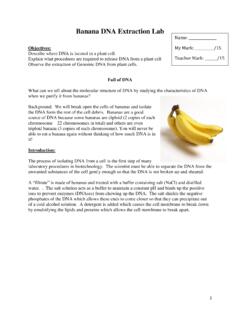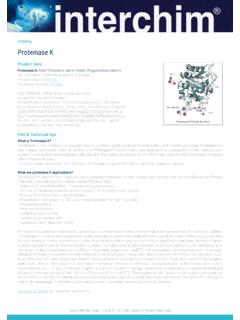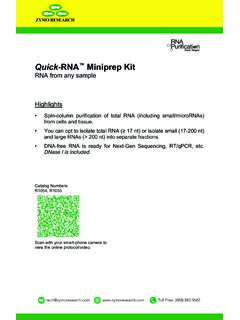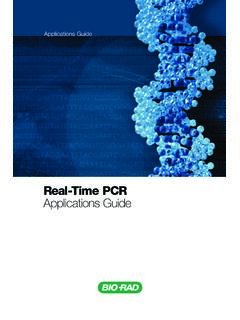Transcription of Extracting DNA Using Phenol-Chloroform - PacBio
1 Page 1 Please note: the shared protocols described herein may not have been validated by Pacific Biosciences and are provided as-is and without any warranty. Use of these protocols is offered to those customers who understand and accept the associated terms and conditions and wish to take advantage of their potential to help prepare samples for analysis Using the PacBio RS system. If any of these protocols are to be used in a production environment, it i s the responsibility of the end user to perform the required validation. Extracting DNA Using Phenol-Chloroform Reagents Needed 1. phenol / chloroform /isoamyl alcohol (PCI) solution (25:24:1) DNase (RNase- and Protease-Free - Molecular Biology grade), pH Important: acidic pH makes the DNA go into the phenolic layer while RNA goes into the aqueous layer Suppliers 2. chloroform /isoamyl alcohol, 24:1 (Molecular Biology grade) Suppliers 3. Elution Buffer (10 mM Tris-HCl, pH ) 4. NH4 OAc (Molecular Biology grade), concentrated solution (5M ) or powder Supplier: 5.
2 Glycogen, 20 mg/ml (Molecular Biology grade), available from most biological reagent suppliers 6. 100% Ethanol 7. 80% Ethanol Procedure TUBE 1: phenol / chloroform /Isoamyl Alcohol extraction 1. Start with 200 L of material and a tube (label as TUBE 1). If necessary, bring the volume up to 200 L Using the Elution Buffer ( EB ) above. 2. Add an equal volume of the phenol / chloroform /isoamyl alcohol solution to TUBE 1. 3. Vortex TUBE 1 vigorously for 1 minute. 4. Spin TUBE 1 solution at high speed for 5 minutes. 5. Remove ~180 L of the top aqueous solution and place into a new tube, TUBE 2. Avoid picking up any of the phenol / chloroform /isoamyl alcohol phase. 6. Add 200 L of EB to TUBE 1. 7. Vortex TUBE 1 vigorously for 1 minute. 8. Spin TUBE 1 solution at high speed for 5 minutes. 9. Remove as much of the top aqueous solution as possible from TUBE 1 without picking up any of the phenol / chloroform /isoamyl alcohol phase. Add the solution to TUBE 2. PacBio SampleNet Shared Protocol Page 2 TUBE 2: chloroform Back extraction (the following steps are to be performed in TUBE 2) 10.
3 Add equal volumes of the chloroform /isoamyl alcohol solution to TUBE 2. 11. Vortex TUBE 2 vigorously for 1 minute. 12. Spin TUBE 2 solution at high speed for 5 minutes. 13. Remove as much of the top aqueous solution as possible and place into a new tube, TUBE 3. Avoid picking up any of the chloroform /isoamyl alcohol phase. TUBE 3: Ethanol Precipitation (the following steps are to be performed in TUBE 3) 14. Add NH4 OAc to a final concentration of M. 15. Add 1 L of glycogen (20 g). 16. Mix solution well. 17. Add volume of 100% ethanol and mix well. 18. Incubate at 20 C (optional). 19. Spin for 20 minutes in a 4 C centrifuge at top speed. 20. Decant supernatant carefully without disturbing the pellet. 21. Wash by adding 300 L of 80% EtOH and vortex 3 times. 22. Spin for 15 minutes in a 4 C centrifuge at top speed. 23. Decant supernatant carefully without disturbing the pellet. 24. Repeat steps 21 23 for a second 80% EtOH wash. 25. Quick spin on table top centrifuge to draw residual EtOH to the bottom.
4 26. Remove residual EtOH with a P20 pipette. Be careful not to disturb the pellet. 27. Air dry for 1-2 minutes. 28. Re-suspend in appropriate volume EB (based on input amount). For Research Use Only. Not for use in diagnostic procedures. Copyright 2012, Pacific Biosciences of California, Inc. All rights reserved. Information in this document is subject to change without notice. Pacific Biosciences assumes no responsibility for any errors or omissions in this document. Certain notices, terms, conditions and/or use restrictions may pertain to your use of Pacific Biosciences products and/or third party products. Please refer to the applicable Pacific Biosciences Terms and Conditions of Sale and to the applicable license terms at Pacific Biosciences, the Pacific Biosciences logo, PacBio , SMRT and SMRT bell are trademarks of Pacific Biosciences in the United States and/or certain other countries.
5 All other trademarks are the sole property of their respective owners.








